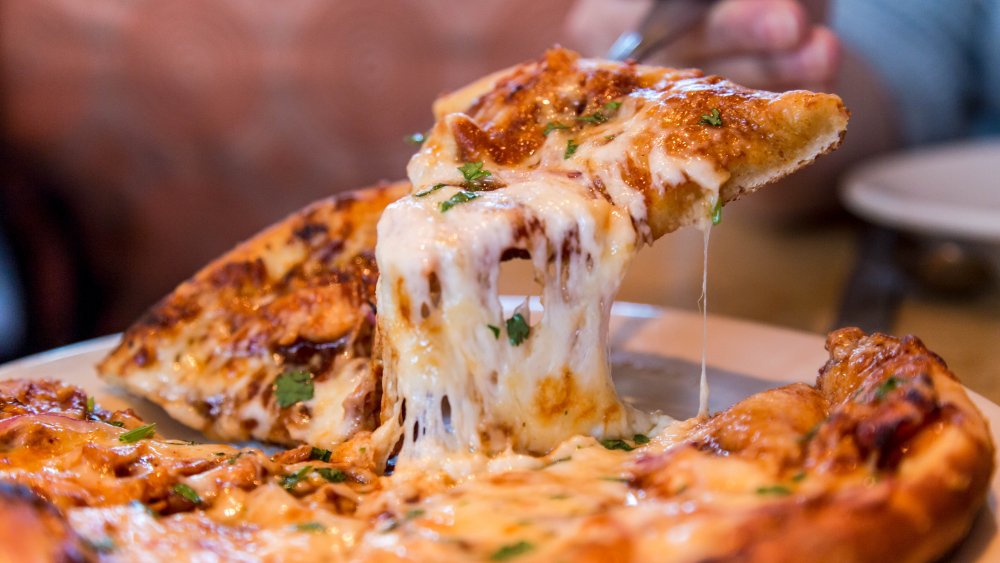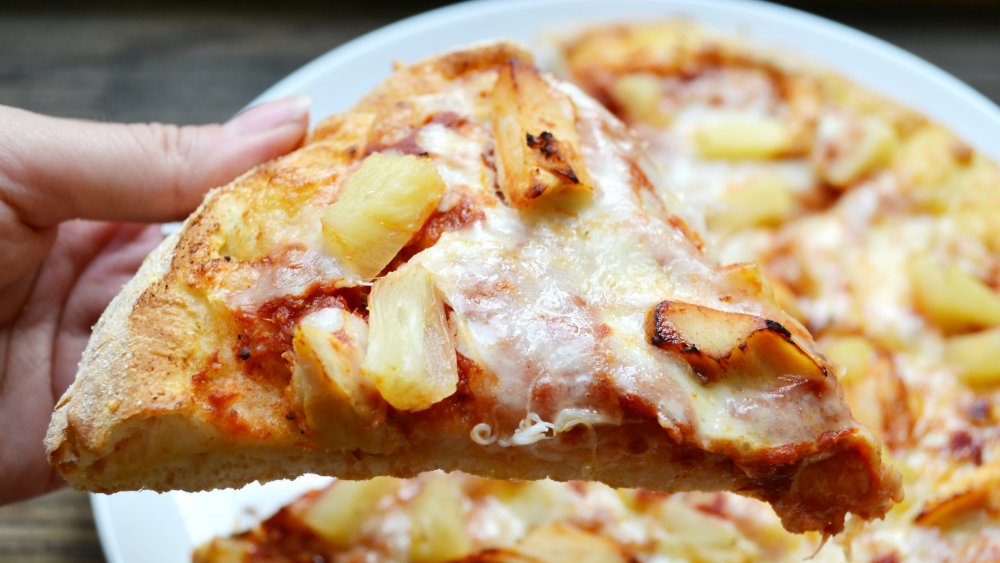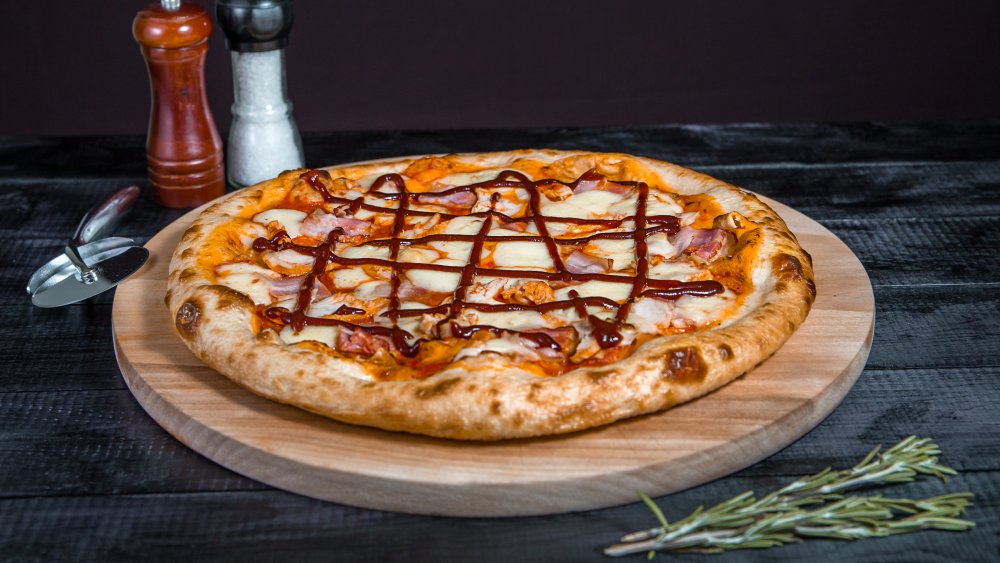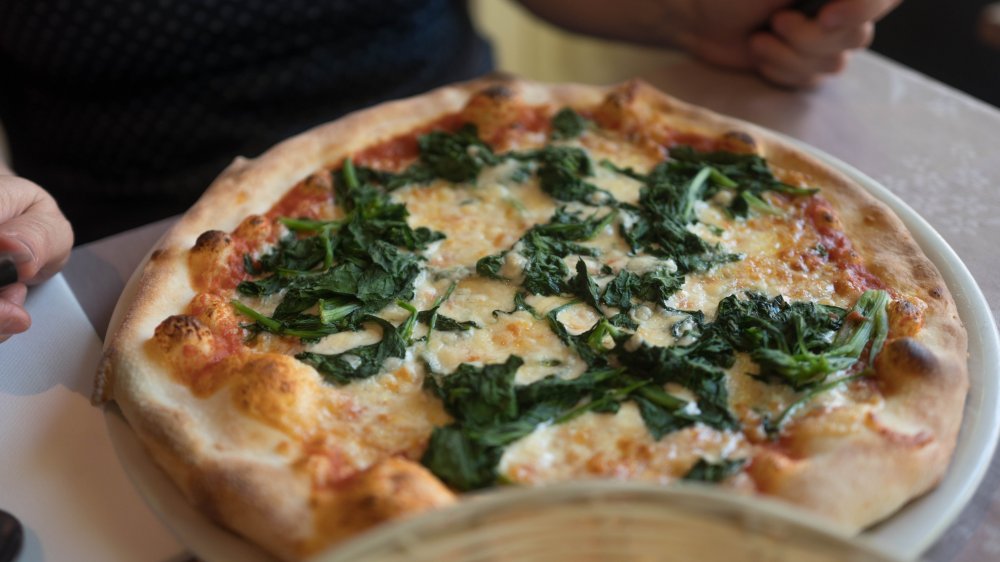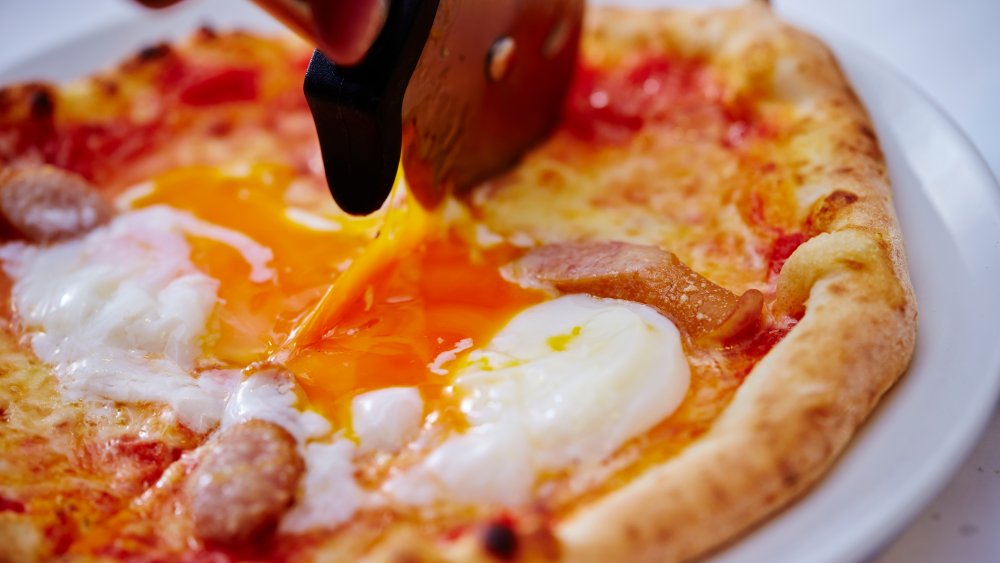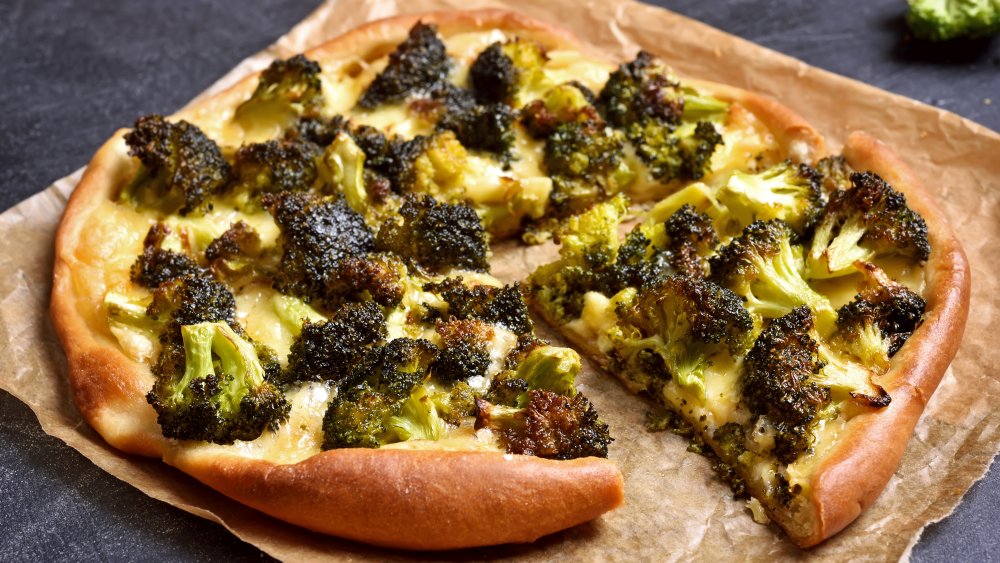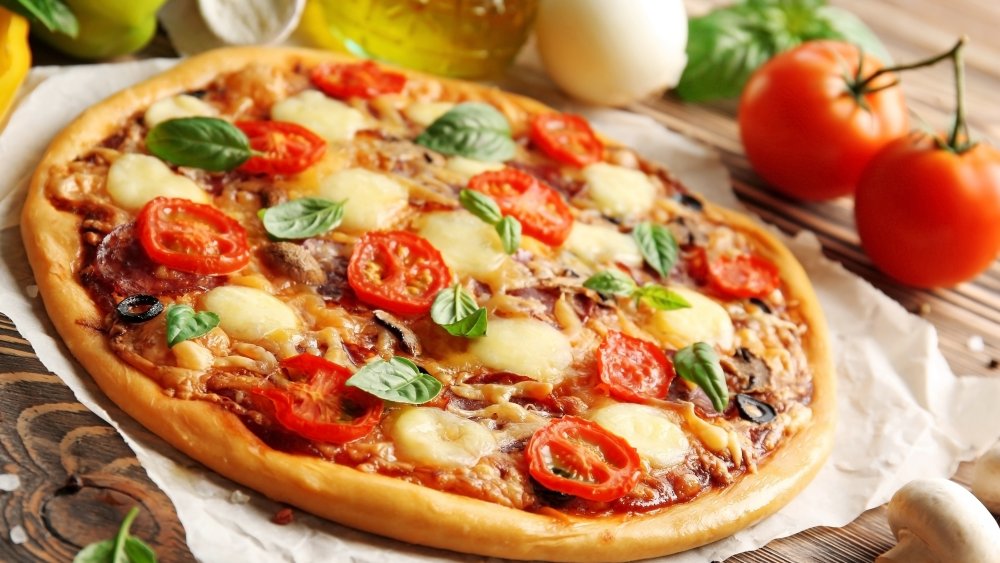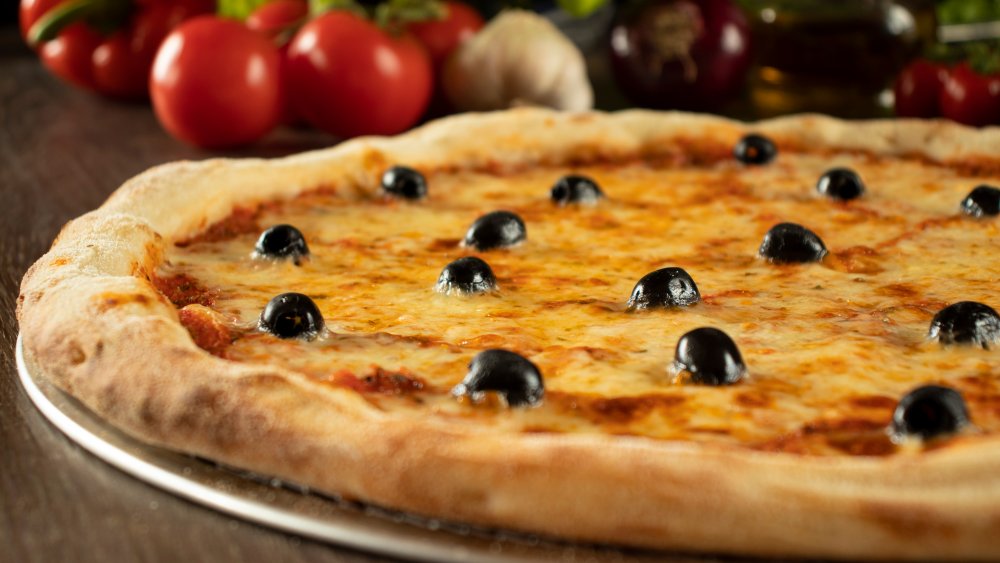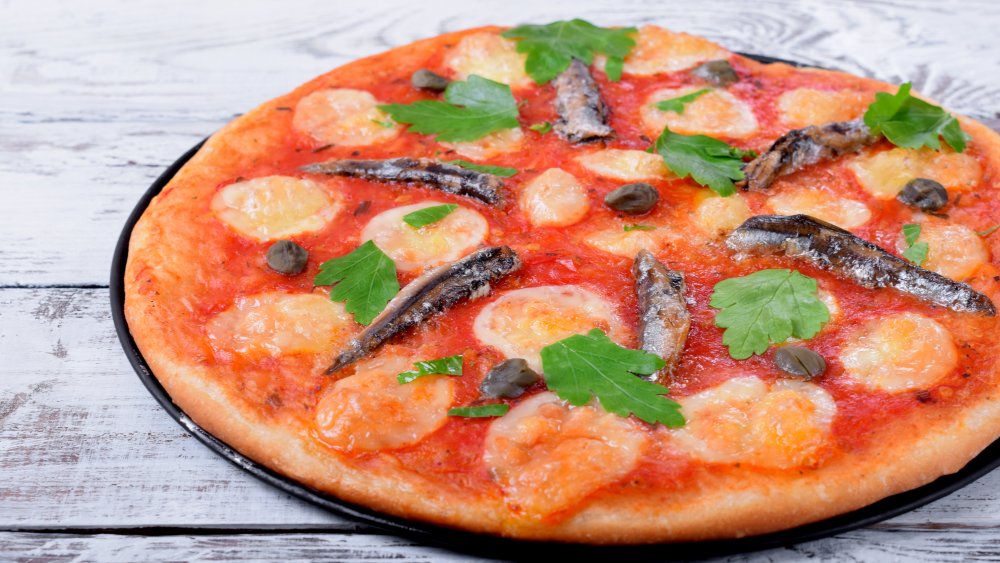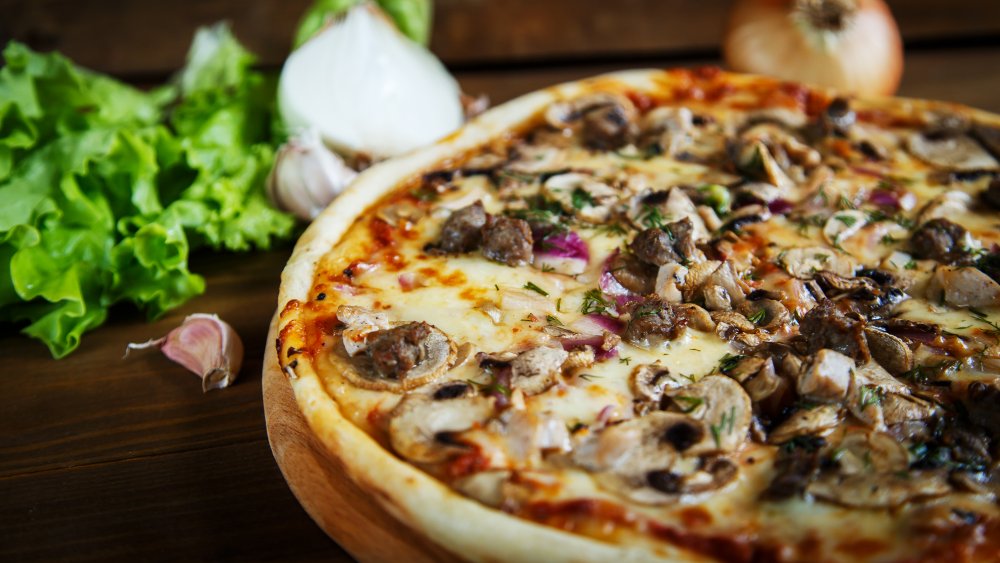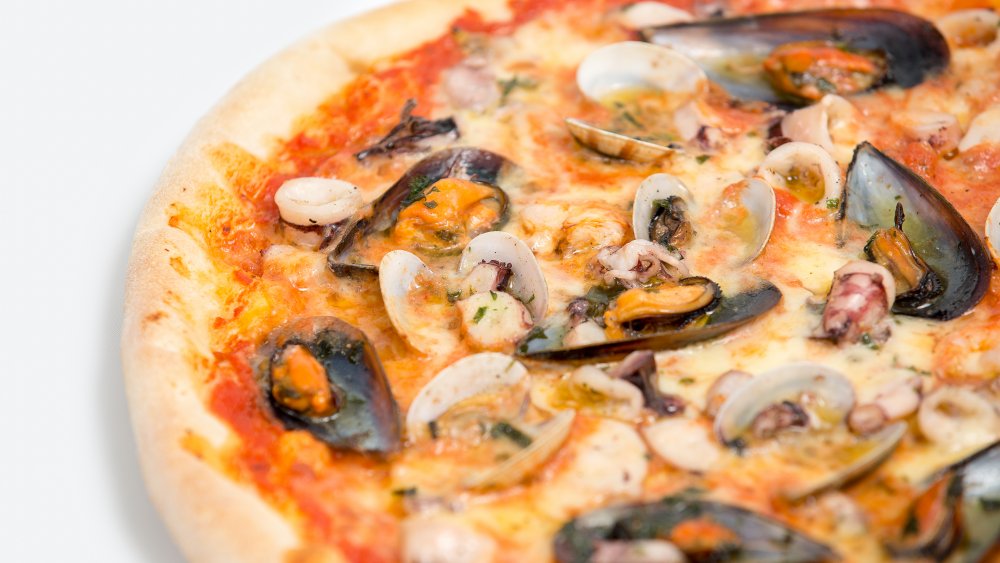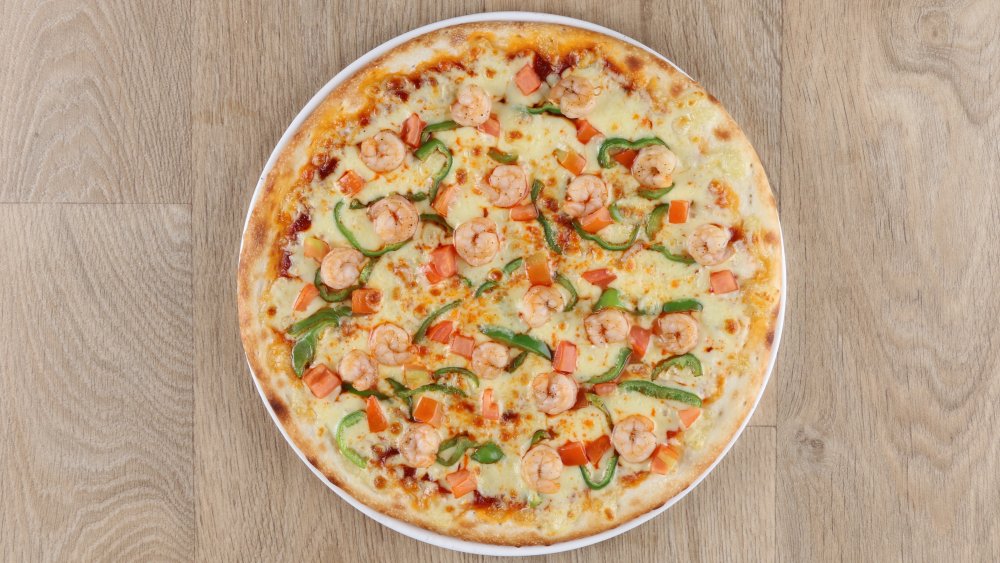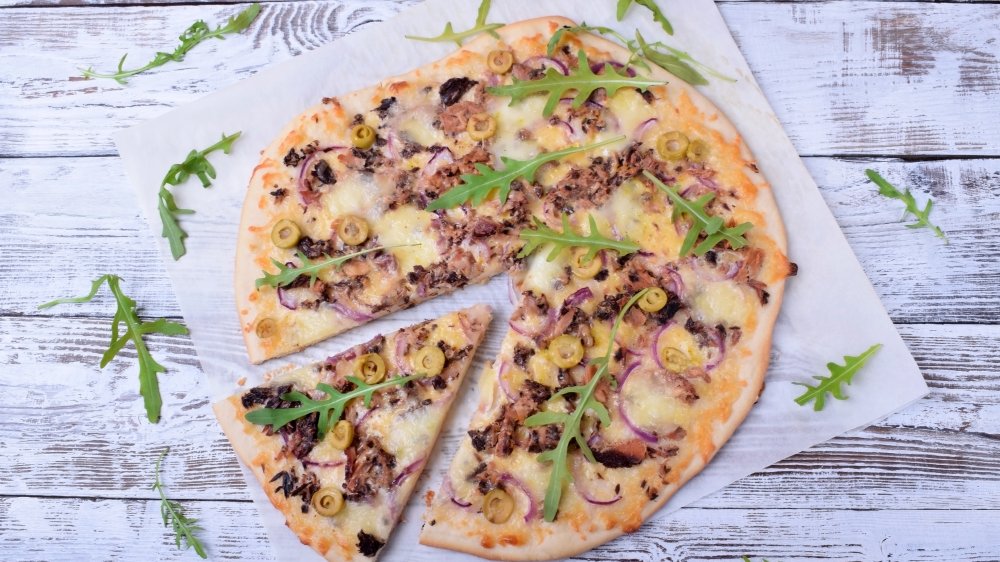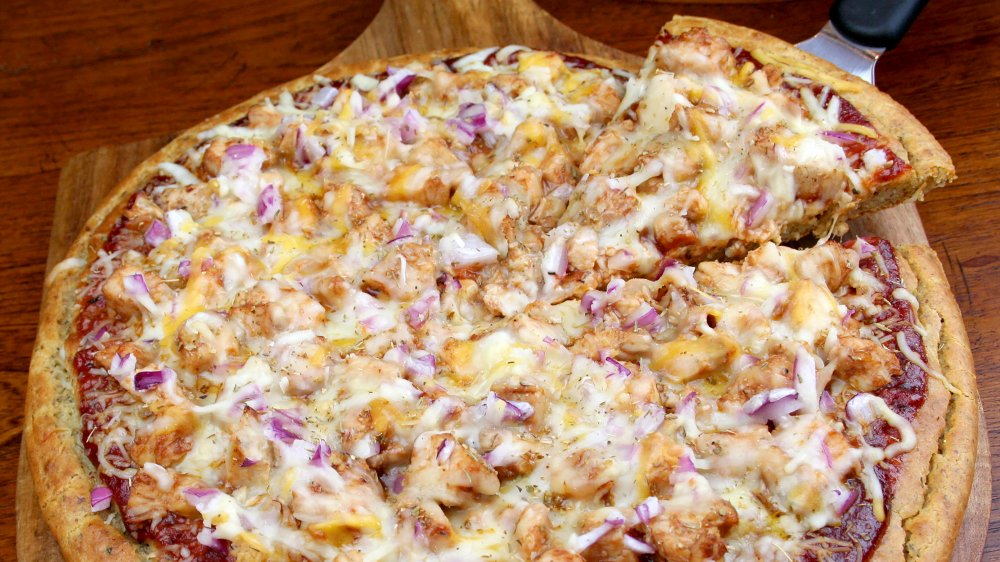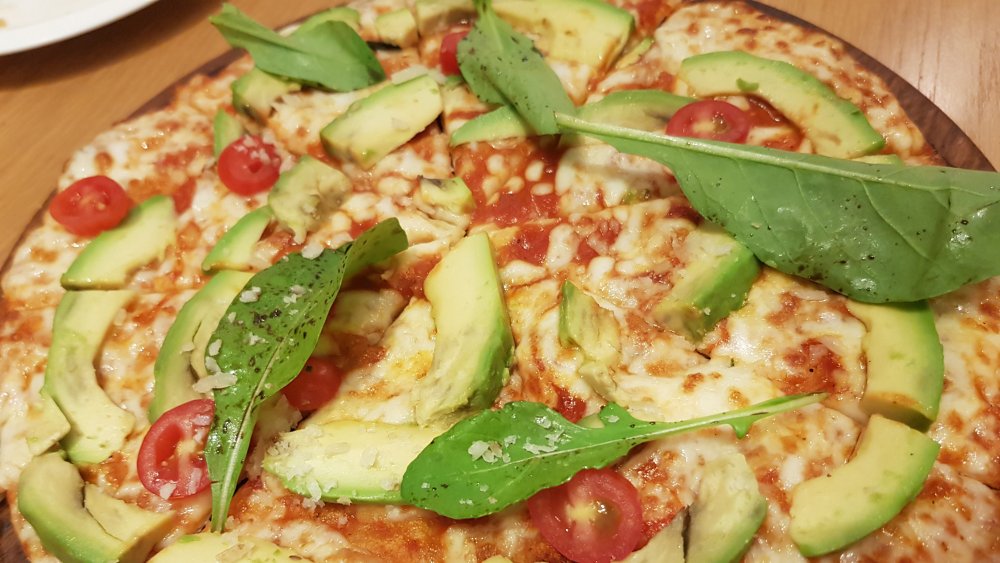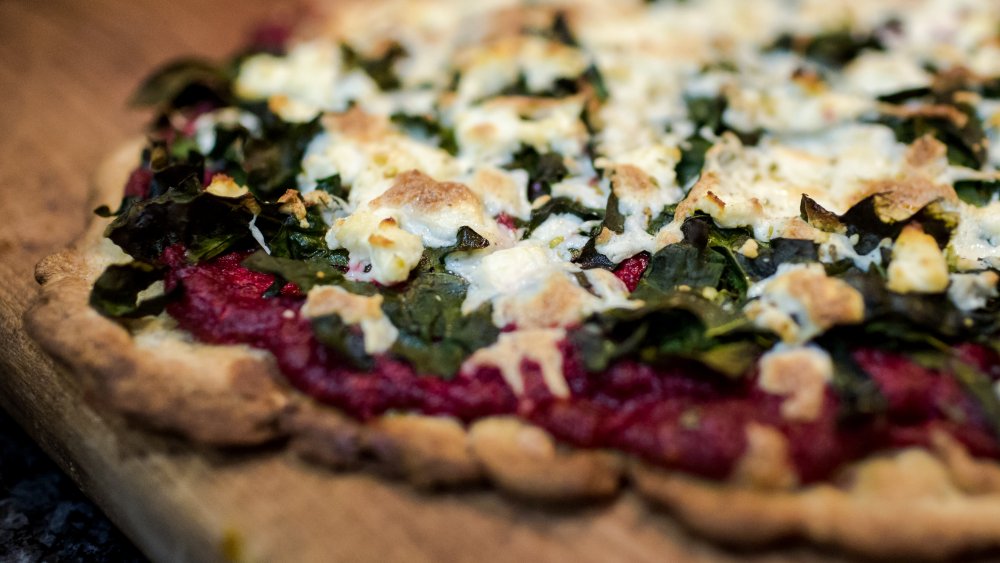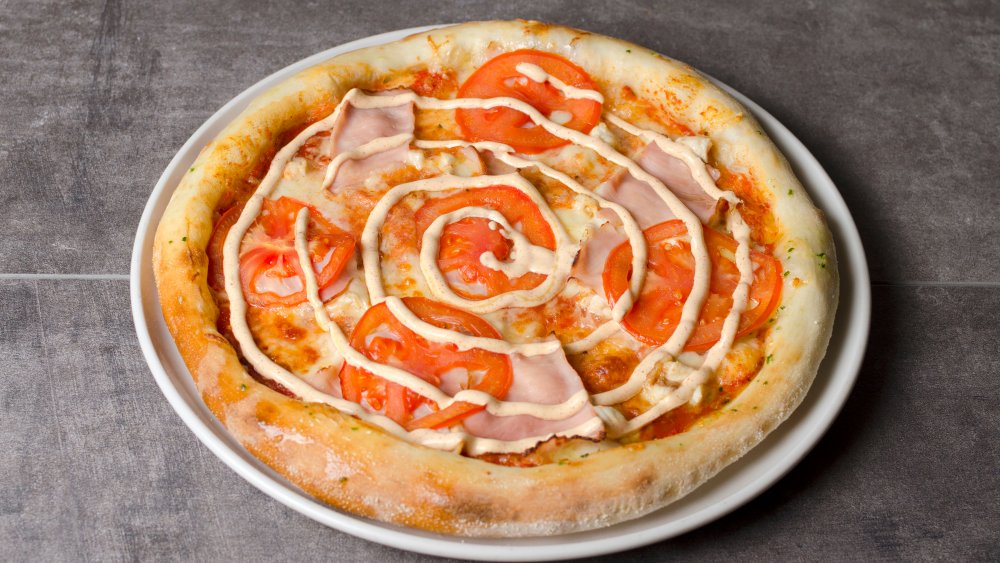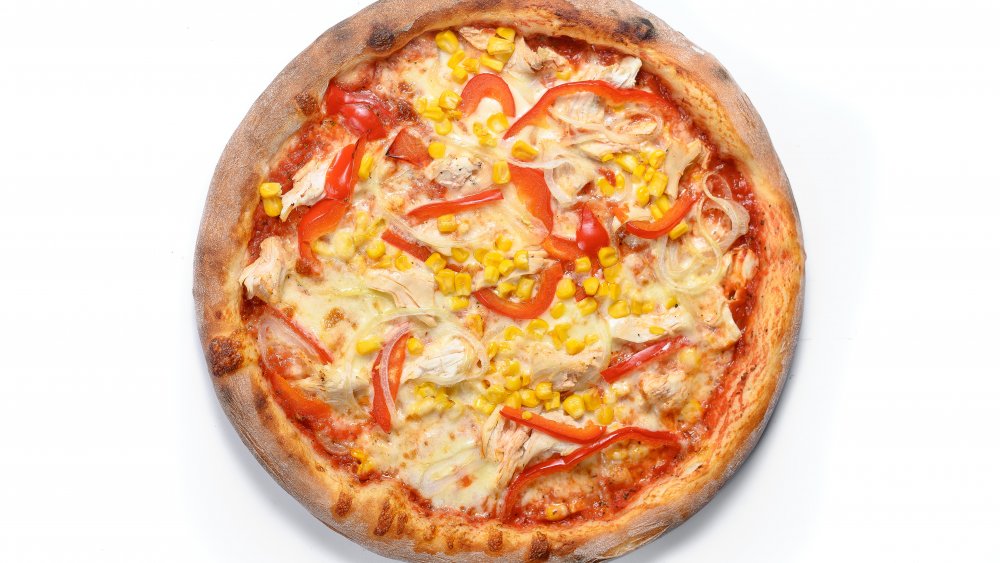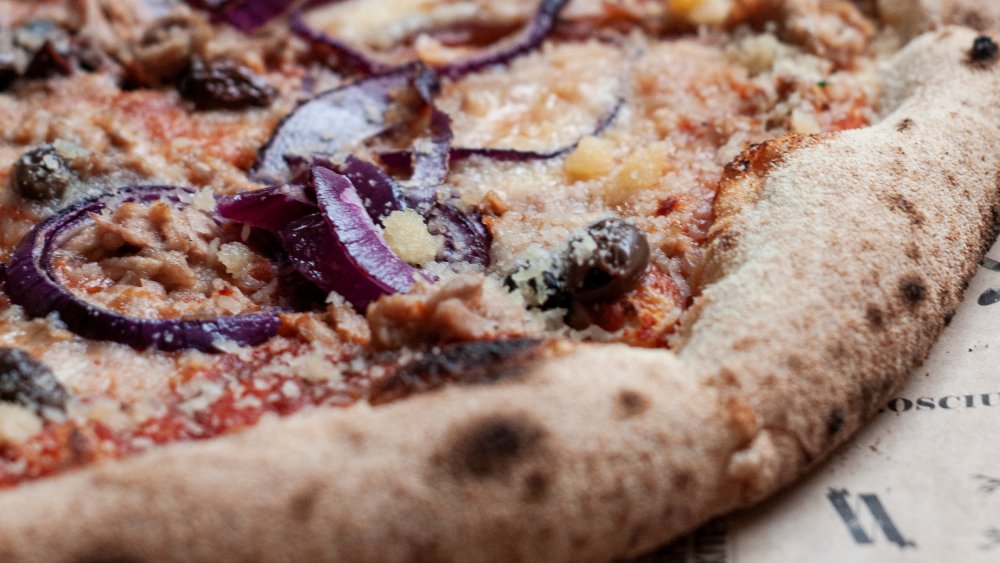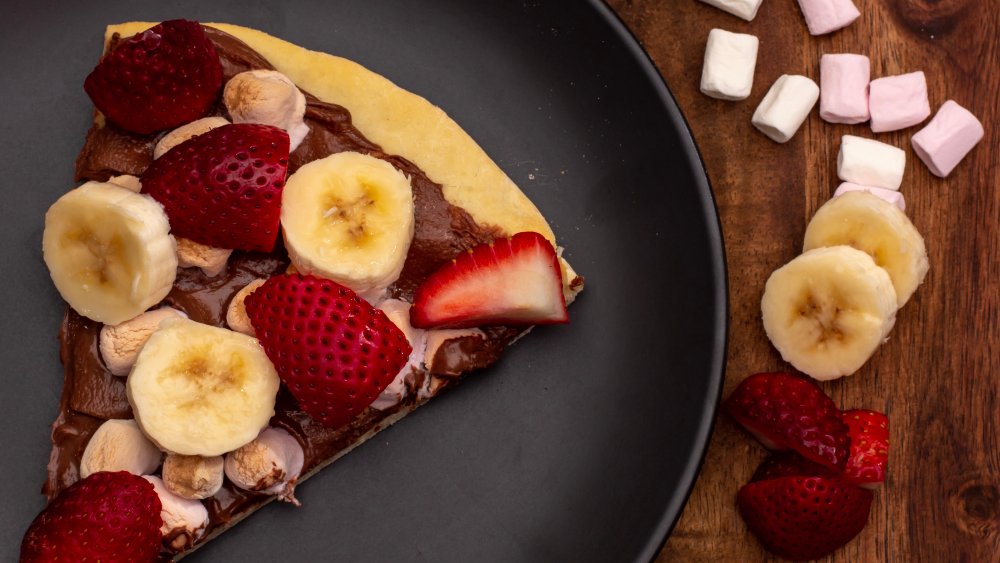These Are The Most Hated Pizza Toppings
Ah, pizza. Pizza is one of the most magical delicacies on the planet. Known for its perfect combination of crust, sauce, and cheese, pizza is a go-to for so many households because of its versatility and ability for customization. Around three billion pizzas a year are sold in just the United States, and really, the only true downside of pizza is having too many toppings to choose from.
Long gone are the days of simply adding pepperoni to your pie and calling it a day. Now, people are adding everything from pesto, to spinach, to potatoes. But those crazy combinations do not come without negative comments. At this point, pretty well anything you dream up could be added to a pizza before making its way to the oven. But, there are just some pizza toppings that are a bit more controversial than your plain cheese — some are even pretty hated. These are the most hated pizza toppings, explained.
Pineapple
If there was any controversial pizza topping to start this list off with, it's definitely pineapple. Seriously, people have been arguing about this sweet topping option for decades.
Putting pineapple on pizza dates back to 1962 when Sam Panopoulos was looking for a new way to attract customers to his Ontario, Canada pizza joint. It was an experiment for them, pairing the sweet pineapple with savory ham, but people loved the contrasting flavors, and Panopoulos eventually named it the Hawaiian Pizza. So many people loved it, and it grew to the ridiculous popularity it has today, and pretty well every pizza chain offers the famed combo. But, with fame comes a whole lot of backlash sometimes.
Some people seem to think that pineapple is the most atrocious option for a pizza, and pineapple-haters are diehard advocates for leaving it off their pie. In 2017, the president of Iceland, Guðni Jóhannesson, joked that he was "fundamentally opposed" to putting pineapple on pizza. A few months later, an employee at a pizza joint in Tucson, Arizona intentionally skipped the pineapple on a customer's order, leaving them a note on the box saying they couldn't bring themselves to do it. The duel between pineapple-lovers and haters is real, and it's so heated that this one will probably go on forever.
Barbecue Sauce
If you've ever had barbecue sauce on pizza, you can easily attest to this controversy. Especially if you're with a group of friends, deciding on whether it's an appropriate topping option can get a little heated.
According to Pop Sugar, California Pizza Kitchen invented the barbecue chicken pizza as a way to move away from traditional pizza toppings. The new pizza was invented in 1985, and according to a California Pizza Kitchen rep, this is still their most popular pizza to date. Since then, many pizza joints have started carrying BBQ sauce as a sauce option, offering everything from Hawaiian pizzas with barbecue, to specialties with pulled pork and red onion.
But despite its rise in popularity, there are definitely still people out there who think it's absurd. One Redditor sparked a discussion on Reddit's Unpopular Opinion feed stating "Barbecue sauce on any pizza is just gross and completely ruins it. The worst is when the pizza sauce is entirely replaced with barbecue sauce," and others followed suit. It's still up for debate depending on a person's taste buds, but with barbecue pizza going strong for decades, it's probably here to stay.
Spinach
Whether you put it in your breakfast smoothie every morning, or you've only heard of it because of Popeye, you've surely had spinach a time or two. But have you ever tried it on a pizza?
According to Fox News, spinach is actually the most nutritional pizza topping you can choose. You know, if you're actually looking to make pizza healthy. Spinach has been known to reduce oxidative stress, reduce blood pressure, and it may even be beneficial for eye health. So, wouldn't putting spinach on your pizza be an automatic? Well, not so fast.
One Redditor started a thread against adding the green leafy vegetable to pizza, saying it made their pie incredibly soggy, while another response stated, "Wet, slimy, icky nonsense. No, just no."
Spinach doesn't keep its freshness when baked in a high heat oven, losing its texture. It all boils down to personal preference, but plenty of people are thinking that texture is far more important than the potential health benefits.
Egg
You've probably heard than any sad meal is made better if you just put an egg on it. So, that must apply for pizza, right? Well, for some people, that rule apparently doesn't apply for everything, and especially not pizza.
According to Woman's Day, putting an egg on top of a pie is ridiculously popular in France, and it's gaining in popularity elsewhere, whether an egg is actually cracked on top of the pizza before putting it in the oven, or the egg is fried and then added on later. Either way, the eggs are usually runny, with the yolk adding to both the taste and texture of the pizza.
Louis Bron, a New York City pizza chef and consultant, told The Independent that he believes eggs don't belong on pizza or flatbread. This doesn't seem to be a debate people are settling just yet. For now, we suppose it all just comes down to whether you enjoy it or not.
Broccoli
Just Like spinach, broccoli has a special place in our hearts. It's a great vegetable, offering so many health benefits. It's packed with vitamins, minerals, and antioxidants, and don't forget about all of the beneficial fiber. But again, is adding broccoli to your pizza the answer because you want to feel less guilty? Well, it is for some.
Broccoli is a pretty unpopular vegetable to begin with, especially with kids. Those tiny trees are bad enough on the side of your dinner plate, but on pizza.... no way.
On the other side of the debate, Serious Eats seems to think we should be putting more broccoli on pizza and cooking it raw and at high temps. According to them, broccoli should go on raw, and come out of the oven barely cooked with a bit of crunch, with charred edges.
It seems the jury is still out on this debate.
Raw tomatoes
Pizza has been around for a long time. We're talking centuries, and in that time a lot has changed. However, one thing that has stayed pretty consistent is that if you take some dough, top it with tomato sauce, sprinkle it with cheese, and put it in an oven, you will have a pizza. But if you're putting together a pizza with a tomato sauce, do you really need to add even more tomatoes? Some people say yes, but that's definitely not without debate.
Adding fresh tomatoes to a pizza, especially paired with ingredients like basil, creates a bruschetta-type pie, adding an element of freshness to an otherwise heavy food. But according to Good Food, adding any more tomatoes than what's in the sauce is unnecessary. In Thrillist's ranking of the best pizza toppings, tomatoes didn't fare too well, noting that adding raw tomatoes makes for too much moisture on the pie, making it too watery and soggy.
Perhaps it's all about finding the perfect balance, tomato lovers.
Olives
Just in general, when you talk about olives, mixed opinions always come up. Whether it's Kalamata olives or canned black olives, there's definitely a polarizing effect when the topic is brought up.
When it comes to the olive controversy, it all boils down to the type of olive being used and its flavor. According to Thrillist, olives can have an overpowering chemical taste, especially when you're eating canned black olives. Canned olives come jam-packed with a ton of sodium, with almost 250 milligrams in just ¼ cup. While on the other hand, some people love the salty flavor they bring to a dish.
But when it comes to olives on a pizza, especially those with pits, many say it's a hard no, including Louis Bron, a New York City pizza chef and consultant, who told The Independent that "anything dangerous like olives with pits," should really be avoided on a pizza.
Serious Eats took a poll on the matter, and less than half of respondents said an unconditional yes to olives on pizza.
Anchovies
Oh, anchovies, those tiny fish many of us have a hard time accepting. There are people who say they don't eat fish at all, but they'll order a Caesar salad at a restaurant. Anchovies come hidden in Caesar dressing, jam-packed with other flavors, so it's not as easy to recognize them. But used as a pizza topping? They're pretty darn obvious.
According to Paste Magazine, anchovies on pizza is not a revolutionary idea. In fact, one of the very earliest pizza combos had anchovies on it, perhaps influenced by the Italians' love of eating fish on bread. When pizza made its way to the U.S., anchovies came with it, but they weren't necessarily as accepted by those who didn't grew up eating the little fish.
In 2017, a pizza survey asked people how they felt about certain pizza toppings, and anchovies made the list. According to Today, 86 percent of respondents said no to adding fish to pizza. Certainly, there's still plenty of people adding them to their pies, but there's definitely a large population saying no.
Mushrooms
The conversation surrounding mushrooms is always a debate in itself. Typically, mushrooms are grouped into the veggie family, but according to PBS, although they're often lumped into that category, mushrooms are indeed a fungus. Yum!
A 2017 survey actually found that mushrooms are the preferred topping choice in the U.K., even beating out ham and pepperoni. But despite their popularity, there are definitely mushroom-haters to rally that they don't belong on a pizza.
In its list of toppings that don't belong on a pizza, Good Food said that mushrooms are already disgusting from a can, but after the oven "they take on the texture of a used surgical swab." Another hater on Reddit noted their texture as well, saying they're gross and that the texture doesn't match pizza at all. Since mushrooms don't really impart that much original flavor, it definitely seems to come down to a texture thing.
Clams
People really get creative with this one, adding clams, sometimes still in their shells, to their pizza. And like other controversial toppings, there's definitely a group of die-hard enthusiasts and plenty of those who hate it.
A longtime pizza joint in Connecticut's New Haven neighborhood is known to have invented the clam pizza, with founder Frank Pepe's history in pizza dating back to 1925. The pizza was invented during the 1960s, at the same time the pizza joint was serving clams on the half shell. Since then, the clam pizza debate has boomed, and it especially gained interest once a New York Times writer claimed that pizzas with clams on them are truly the best.
There are others that say the flavors (and the smells) just don't mix, and we can't help but agree. Clams are delicious, but keep them far, far away from our pizza.
Shrimp
People love shrimp — it's one of the most widely consumed seafood products in the country. And, surprisingly enough, shrimp is a popular pizza topping around the world. It's found on barbecue sauce-based seafood pizzas in Australia, coconut and shrimp pizzas in Costa Rica, and a bizarre shrimp, potato, and cookie crust pizza from South-Korean-based Mr. Pizza. Online, you'll find dozens of recipes for a pizza called "shrimp scampi pizza," which takes the buttery, garlic-forward flavors of the classic Italian pasta dish and dumps it onto pizza dough to transform it into a new dish.
So, if so many people love shrimp pizza, what's so wrong about the concoction? Only everything. In Italian cuisine, mixing seafood and cheese is strictly prohibited. There might be several deviations from this rule in other cuisines, like the classic French dish Moules au Roquefort, which mixes mussels with blue cheese. But in Italy, it's not done. Since pizza originated in Italy, we have to follow the rules: Don't mix shrimp and cheese.
Canned tuna fish
There are certainly some weird pizza toppings around the world, but chicken of the sea — canned tuna fish — has to be the weirdest (and, ahem, probably the grossest). It's one thing to make a shrimp scampi pizza (we don't agree, but we can understand the flavor profile and its appeal). It's another thing to add anchovies to your pie. Again, not our cup of tea, but we understand the desire to add salty fish to a cheesy pizza. Opening up a can of tuna and plopping it on the pizza, on the other hand, is just a bit too fishy for us.
This pizza is wildly popular in Germany, where it's called thunfisch pizza. It not only smells odd (warm tuna fish smells even fishier than cold tuna fish), but it looks weird too. The texture is gross, and it reminds us of something we might feed a cat. If you want to eat tuna fish, enjoy it on a sandwich or salad, but leave pizza alone.
Chicken
In general, when people talk about chicken, it's in a positive way. There's a reason the saying "tastes like chicken" exists — chicken is so ubiquitous, everyone knows what it tastes like. Cooking with chicken crosses cultural borders and can be found in almost every type of cuisine. That said, just like we choose to skip chicken of the sea on pizza, but we would advise to skip chicken as well.
Chicken almost always tastes bad on pizza. First of all, the flavor of the chicken and tomato-based marinara sauces clash. Chicken might be better-suited for pizzas that use pesto, Alfredo sauce, or less traditional sauces like barbecue sauce or buffalo sauce, but it still doesn't taste stellar. The biggest problem is the dry heat of the oven. Pizza ovens need to be very hot to create a proper pie, which will dry out an already dry piece of chicken. No amount of barbecue sauce can save you from its terrible texture. And if you really want buffalo wings on your pizza, do yourself a favor and just order a side of real buffalo wings instead of trying to combine the two.
Avocado
For a long time, avocados were mostly unknown (except for its use as guacamole at Mexican restaurants or Super Bowl parties). Somewhere along the way, avocado launched and became a household staple. People started using it instead of butter in baked goods and as a way to elevate toast and turkey sandwiches into restaurant-worthy dishes. It's only natural that people would want to put their new favorite fruit on pizza, but sadly it just doesn't belong.
Pizza crust doesn't have much flavor on its own, so it needs things like sauce and toppings to provide pizza's characteristic flavor. That totally works when you add marinara sauce, pesto, or Alfredo and any number of pizza toppings, but avocado doesn't contribute much flavor on its own. Without salt and flavorings like garlic or onion, an avocado doesn't taste like much. Put it on a pizza, and what does it add? Just a buttery texture. Plus, avocado gets weird and slimy when it's heated. All in all, we're going to say thanks, but no thanks.
Kale
Before its rise to trendy fame in the early 2010s, the largest purchaser of kale was restaurants like Pizza Hut and Ruby Tuesdays — as decoration for their salad bar. It's true; no one was eating the kale, it was just used for display! Today, kale has launched to superfood status, and you'll find it in just about everything (despite the fact that several other cruciferous vegetables have just as many nutrients and naturally taste better).
So what's our beef with kale on pizza? It just doesn't taste that great. Just like broccoli, adding kale to pizza seems to be a way to appease our guilty consciousness by including a so-called healthy ingredient on an otherwise unhealthy dish. You'll end up with soggy, bitter leaves if the kale is placed beneath the cheese, or crispy, charred bits if it's placed atop the cheese. Either way, if you're looking to add nutrients to your diet, skip the kale on pizza. It will taste much better if you order a side of sauteed greens or a soup made with kale instead.
Ranch dressing
We know that Americans love ranch dressing. In a poll reported on by The New York Times, 40 percent of Americans listed ranch as their favorite salad dressing, and not just for use in salad. Ranch has branched out to become everyone's favorite dip for spicy chicken wings or fried mozzarella sticks, and we drizzle it on everything from mac and cheese to french fries and baked potatoes.
Don't get us wrong — we're not anti-ranch. We love using ranch, and it's great for a lot of recipes, but pizza isn't one of them. Think about what ranch is really made of. At its most basic, it's a combination of mayonnaise, sour cream, and buttermilk. Would you put mayonnaise on pizza? No way. Sour cream or buttermilk? We think not. These types of sauces would thicken unpleasantly or curdle in a hot pizza oven. So let's agree it might be best to skip using a combination of all three when you bake up your next slice of pie (and don't of adding it after it's baked, either).
Corn
Apparently, corn is a pretty popular ingredient on pizza outside the United States. It's a common topping in the UK, Japan, and Korea. A thread on Reddit posted by someone in the UK titled "Is it true you don't put corn on pizza?" turned out some pretty hilarious comments (including some people wondering if corn on pizza was the true reason behind the Revolutionary War).
For Americans, corn on pizza is just... weird. It's not a natural combination of flavors or textures, and it turns out oddly crunchy and watery. Not exactly the best way to enjoy a cheesy pie! Not only that, but adding corn to pizza creates the fusion between two cuisines (Mexican and Italian), creating flavors that don't necessarily go together. Worse yet, you can't exactly pick corn off of the pizza because the kernels are too small. So, do us a favor and keep the corn on the cob and off the pie.
Raw onions
It's well documented that onions are one of the most used cooking ingredients. They add rich flavor to soups and stews, and it's difficult to imagine many of our favorite dishes without them. That said, there is a big difference between cooked and raw onions. Raw onions are pungent and potent, so much so that you may cry when chopping them. Given time to cook, onions develop rich flavors that are simultaneously sweet and savory.
We have no problem with including onions in tomato-based marinara sauces or even adding cooked or caramelized onions to balance out meat-heavy pizzas. But adding raw onions on a pizza is a no-go. The heat of a pizza oven might be intense (as hot as 700 degrees Fahrenheit), but pizzas cooked at these intense temperatures are flash cooked in a matter of minutes. That doesn't give the onion a chance to soften and mellow, leaving you with a pizza topped with crispy, crunchy, raw bite of onion that will overpower all the other flavors.
Dessert pizza toppings
Dessert pizza: Just. Don't. Do. It. A pizza covered Nutella, chocolate chips, marshmallows, and bananas might sound (and even taste) good. But this pizza isn't truly pizza. We hate to get technical on you, but Merriam Webster defines pizza as, "A dish made typically of flattened bread dough spread with a savory mixture usually including tomatoes and cheese and often other toppings and baked." See the word "savory" in there?
It's one thing to include sweet elements on a pizza by drizzling honey on a pizza or including pineapple on your pie (the most controversial ingredient of all). But dessert pizza doesn't contain any salty ingredients at all, and salt is a necessary component of a good pizza. Not to mention that pizza just isn't pizza without cheese. Adding sweet, dessert toppings to a pizza is a sad excuse not to make a proper dessert pie. So do us all a favor, and don't entertain anyone who is doing it. Maybe, if we all ignore dessert pizza, it will just go away.
